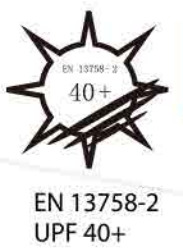EN 13758 UV protective clothing CE certification UV testing
En 13758-2:2003+a1:2006- UV protective clothing

The En 13758 standard specifies marking requirements for clothing designed to protect wearers from solar ultraviolet (UV) radiation. The standard specifies a method for measuring the redspot weighted ultraviolet (UV) radiation transmittance of standard conditioning clothing fabrics to evaluate their solar UV protection performance. This method is not suitable for fabrics that provide protection in the distance, such as umbrellas, shading structures, or artificial light sources.
EN 13758-1:2002 Textiles – Sun UV protection performance – Test methods for clothing fabrics
EN 13758-2-2003 Textiles – Solar UV protection performance – Part 2: Classification and marking of clothing
| UPF range | protect | % UV blocking | Label level |
| 15-24 | good | 93.3%-95.8% | 15,20 |
| 25-39 | Very good | 96%-97.4% | 25,30,35 |
| 40-50+ | Excellent | 97.5%-98+% | 40.45,50,50+ |
Clothing marked according to EN13758-2 can protect UVA+UVB from harmful ultraviolet rays. Prolonged exposure to sunlight can cause skin damage. Wearing protective clothing designed according to this standard can reduce the danger caused by ultraviolet radiation. Although this type of clothing can prevent UV radiation, wearing it does not guarantee protection under all conditions.
Please note that only the area covered by the clothing is protected, and the protection provided by the clothing may reduce usage if stretched or damp. UV protective clothing should be taken care of according to the instructions inside each piece of clothing.
The level of protection depends on different factors, such as fabric weight and thickness, as well as clothing design. If the clothing fabric is stretched, or if the clothing gets wet or worn, the protection may be reduced. Be sure to properly close protective clothing and be aware that only areas covered by protective clothing will be protected.
The first part of the En 13758 standard (EN 13758-1) covers all details of textile material testing methods (such as spectrophotometry), while the second part (EN 13758-2) covers the classification and labeling of clothing textiles. UV protective fabrics claiming to meet this standard must meet all strict testing, classification, and labeling requirements, including UV Protection Factor (UPF) greater than 40 (UPF 40+), average UVA transmittance less than 5%, and design requirements specified in Part 2 of the standard. A pictogram with EN 13758-2 standard number and UPF of 40+should be attached to the garment if it meets the standard.

CE certification for UV protective clothing:
Starting from April 21, 2019, any clothing claiming to protect the wearer’s skin from sunlight, including hats, gloves, and swimsuits, is required to obtain the CE mark as personal protective equipment (PPE).
This may surprise retailers and consumers, undoubtedly putting an additional burden on the suppliers of these products. They must now ensure that products with UPF declared value must also bear the CE logo before the deadline of April 21, 2019.
To affix the CE mark, the manufacturer must follow the procedures specified in PPE and establish a technical document containing all relevant data, which must be kept for 10 years. Unlike the second and third categories of items, certification bodies are not required to participate in the certification of these items as they have been classified as the first category.
PPE directive for protective clothing:
According to the EU Personal Protective Equipment Regulation 2016/425, UV protective clothing is considered as Class 1 Personal Protective Equipment (PPE).
This requires manufacturers or EU distributors to prepare a technical document that should include at least the following information as required in Annex 1:

1. Risk assessment
The file should include the product name and the protection provided. Manufacturers or EU distributors should have already assessed the risks to be protected by personal protective equipment, including design evaluations. It is recommended to use the requirements of EN 13758-2.
2. Testing
A unified standard has not yet been adopted – but it is recommended to use the recognized standard BS EN 13758-2 for clothing and BS 8466 for hats. Other suitable international standards can be used to monitor consistency, such as AS/NZS 4399 and AATCC 183.
The technical documents should include relevant reports on tests conducted to verify whether personal protective equipment meets applicable requirements.
The fabric or clothing should have a minimum requirement of UPF 40.
3. Product lifespan/performance evaluation
The protective performance of clothing throughout its entire lifecycle should be evaluated.
This may include evaluating UV protection after the expected number of washing cycles to ensure that the clothing still provides the claimed protection.
Describe the methods adopted by manufacturers during the production of personal protective equipment to ensure that the equipment complies with design specifications and monitors the continuity of protection. This may include testing procedures for fabrics.
4. Attach labels to
Manufacturers should label the following information on each item.
CE Mark
Require the CE mark to be provided on the permanently sewn label.
www.allflychina.com
ALL FLY TEAM
19.Mar.,2024

